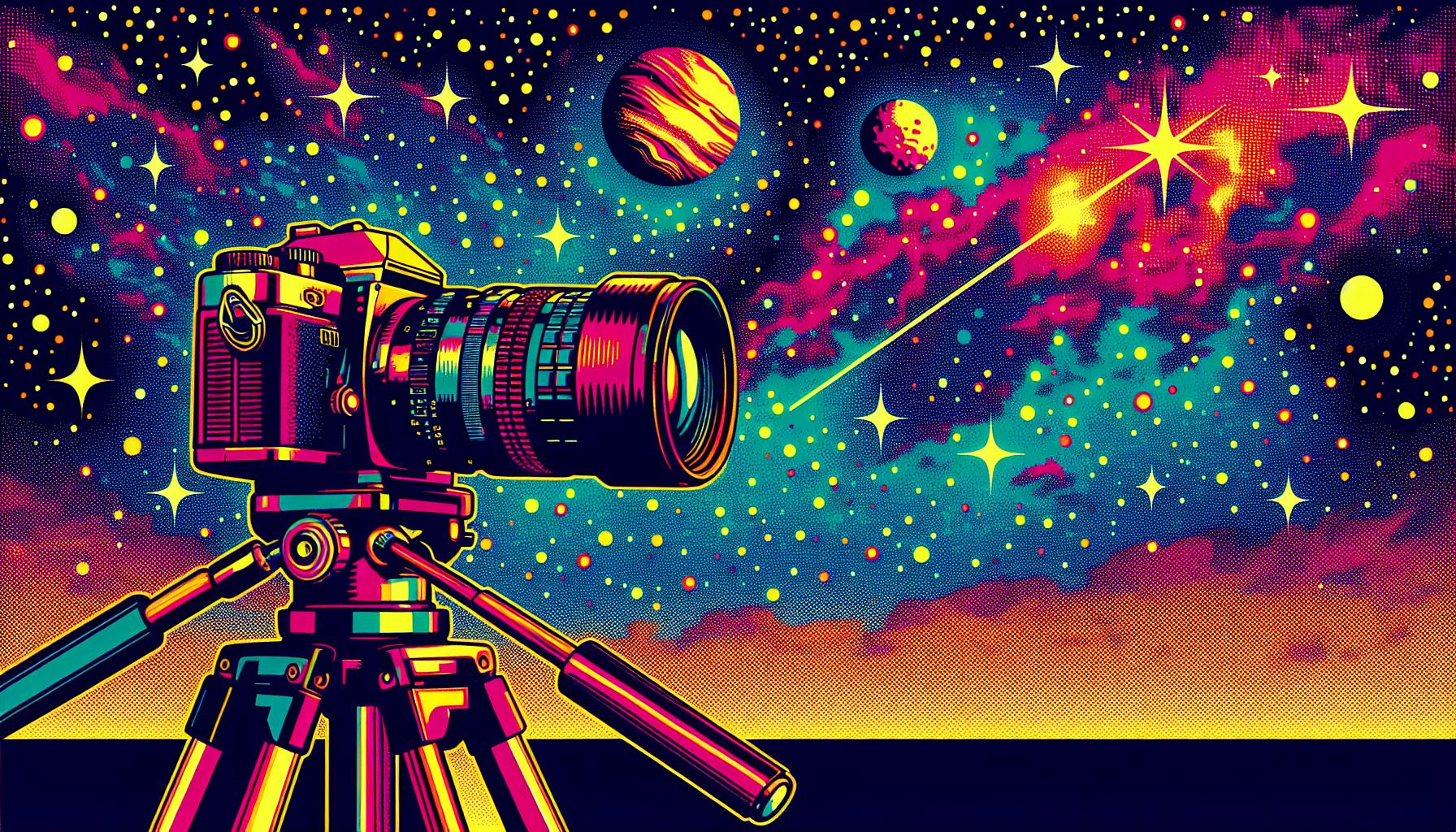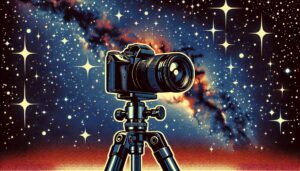This site contains affiliate links to products. I may receive a commission for purchases made through these links.
If you’re like me, you’re always chasing that perfect shot of the cosmos. That’s where Canon’s astrophotography cameras come into play. They’re specifically designed to capture the breathtaking beauty of the night sky.
These cameras aren’t just your run-of-the-mill DSLRs. They’re equipped with features that make them perfect for capturing celestial bodies. With enhanced hydrogen-alpha sensitivity, they can pick up the faintest of red hues emitted by nebulae and galaxies.
In the world of astrophotography, Canon has made a name for itself. Their cameras offer a balance of quality, performance, and affordability. Whether you’re a seasoned stargazer or just starting out, there’s a Canon astrophotography camera for you. Stick around as I delve deeper into what makes these cameras a stellar choice for night sky photography.
Canon Astrophotography Cameras: Capturing the Cosmos
When you think about delving into the realm of astrography, the Canon astrophotography cameras are an excellent choice. Canon EOS-Ra and EOS 60Da are popular models, each with unique features that are worth exploring.
The EOS Ra boasts of its enhanced hydrogen-alpha sensitivity. This feature is specifically designed to capture the beauty of the night sky. It picks up those faint red hues emitted by celestial bodies like nebulae and galaxies. With this camera, it’s almost as if you’re granted a pair of superhero eyes, able to see things beyond what a regular human eye would spot in a night sky. The 30x live view magnification is another notable feather in its cap, a boon for focusing on distant Details.
Here’s a quick overview of the EOS Ra features:
| Feature | Specification |
|---|---|
| Hydrogen-alpha sensitivity | Enhanced |
| Live view magnification | Up to 30x |
Then we have the EOS 60Da, another star player in Canon’s astrophotography line-up. This camera comes with an infrared-blocking filter and an 18 Megapixel CMOS sensor, offering sharp images and details. It’s designed with astronomers in mind. The 60Da model makes it possible to capture phenomena like solar flares in perfect detail, making your astro-shot experience a truly brilliant one.
Below are some EOS 60Da’s vital stats:
| Feature | Specification |
|---|---|
| Infrared-blocking filter | Yes |
| CMOS Sensor | 18 Megapixel |
Whether you are an experienced stargazer or just starting on your journey, these Canon astrophotography cameras provide an ideal balance of quality, performance, and affordability. They are specifically designed to make your experience capturing the cosmos nothing short of magical.
Just imagine having the ability to capture stunning astral events. From distant galaxies to the dazzling ballet of a meteor shower, every single wonder of the cosmos would be within your camera’s reach.
Features That Set Canon Astrophotography Cameras Apart
What sets Canon’s astrophotography cameras apart, you ask? Enhanced Sensitivity and the Ability to Capture Detail would be my instant response. Let’s delve into these nitty-gritties.
The EOS Ra stands head and shoulders above others due to its enhanced hydrogen-alpha sensitivity. What does this mean for astrophotographers? It allows you to capture breathtaking images of distant celestial bodies in unprecedented detail. The faint red hues of nebulae and galaxies that ordinarily go unnoticed can be elegantly captured.
In addition, this camera’s 30x live view magnification feature is a boon for all you stargazers out there. Focusing on those distant celestial details becomes much less daunting. Essentially, it’s like having a telescope incorporated within your camera.
On the other hand, Canon’s EOS 60Da is a stellar choice for capturing unique celestial phenomena. With an infrared-blocking filter and an 18 Megapixel CMOS sensor, it excels at capturing solar flares in all their sunlit glory. The image quality is so sharp; you’d think you’re looking at the astronomical happening right before your eyes.
| Camera Model | Notable Features |
|---|---|
| EOS Ra | Enhanced Hydrogen-Alpha Sensitivity 30x Live View Magnification |
| EOS 60Da | Infrared-Blocking Filter 18 Megapixel CMOS Sensor |
These Canon models offer a perfect fusion of superior quality, robust performance, and an affordable price tag. While experienced stargazers will find their expectations met, these cameras are also user-friendly enough for novices to navigate their way around. Yes, you can indeed start your astrophotography journey with Canon.
Enhanced Hydrogen-Alpha Sensitivity: Revealing the Hidden Beauty of the Night Sky
As an avid astrophotographer, I’ve come to understand that the true beauty of celestial bodies is often hidden by our human eye. But fear not – Canon’s EOS Ra is here to reveal those secret hues. Known for its noteworthy enhanced hydrogen-alpha sensitivity, this camera lets us perceive and capture the subtle red hues emitted from distant nebulae and galaxies.
So, what’s hydrogen-alpha sensitivity, you may wonder? In simple terms, it’s the camera’s ability to detect hydrogen-alpha light – a specific wavelength of red light. This light is emitted from astronomical objects like nebulae and glowing gas in galaxies. Human eyes can’t quite see hydrogen-alpha light, but with a camera like the EOS Ra, those stellar details emerge brightly against the vast, dark backdrop of the cosmic ocean.
The EOS Ra astrophotography camera takes this even further by providing a 30x live view magnification feature. This incredible capability enhances focusing on minute details, such as stars thousands of light-years away. This camera essentially allows us to unlock a window into a hidden universe, revealing the mesmerizing mysteries of space that have captivated humanity for millennia.
In conjunction with these features, you might ask how Canon maintains performance and affordability. Well, they’ve seamlessly balanced these factors, ensuring that even hobbyists aren’t priced out of high-quality astrophotography. With the EOS Ra, both experienced stargazers and newbies can journey into astrophotography, capturing the enchanting spectacles of the night sky with stunning precision.
Yet, in the realm of astronomical photography, the EOS Ra isn’t alone in Canon’s arsenal. The EOS 60Da is another stellar competitor, boasting an 18 Megapixel CMOS sensor suited for catching the eruptions of solar flares. The realm of astrophotography is vast and varied. Depending on your specific interest, there are different tools designed to capture and bring the marvels of the cosmos right to our fingertips.
Canon’s Reputation in the World of Astrophotography
In the realm of astrophotography, it’s Canon’s superior technical prowess and innovation that has made it a favorite among professionals and hobbyists alike. Known for continually advancing camera technology, Canon’s astrophotography-specific models like EOS Ra and EOS 60Da provide an unprecedented opportunity to delve into the beauty of the cosmos.
Canon astrophotography cameras are beloved for their enhanced hydrogen-alpha sensitivity. This unique feature allows these cameras to capture the finesse and depth of the faint red hues emitted by celestial bodies, which are often lost in cameras of lesser sensitivity. This remarkable sensitivity broadens the horizons for astronomy enthusiasts, unlocking a new avenue to explore galaxies, nebulae, and different astronomical phenomena.
The impressive 30x live view magnification present in models like the EOS Ra reinforces Canon’s commitment to quality and detail. This powerful tool aids in focusing on distant celestial details otherwise invisible to the naked eye. For the discerning stargazer who aims to capture the most minute details and produce stunning high-resolution images, Canon’s astrophotography technology is an invaluable asset.
Canon’s astrophotography cameras are not just about high-end features though. One of Canon’s key strengths is its focus on availability and affordability. Both the EOS Ra and EOS 60Da strike that essential balance, making professional-grade astrophotography accessible to not just the seasoned stargazers but also those just venturing into this fascinating hobby.
As the discussion about Canon’s popular astrophotography models unfolds, we’ll delve into the specifications and features that set these cameras apart. And there’s another dimension worth exploring: how Canon’s reputation in the astrophotography field has been shaped by the experiences of its users. This will involve looking into feedback and insights from actual users who have had the chance to capture the beauty of the cosmos through the lens of Canon’s astrophotography cameras.
Finding the Perfect Canon Astrophotography Camera for You
Choosing an astrophotography camera from Canon’s vast array shouldn’t be a daunting task. Key points to help you make an informed choice hinge on your level of experience, the type of celestial objects you’re interested in, and your budget.
As we’ve already discussed, both the EOS Ra and the EOS 60Da are firm favorites among stargazers. The EOS Ra is particularly recommended for shooting nebulae and galaxies, thanks to its capacity to capture those faint red hues. And for lunar and planetary photography enthusiasts, the EOS 60Da, with its powerful live view magnification feature, should be the go-to model.
Think about your level of expertise in astrophotography, too. As a beginner, you’re likely to appreciate the balance between the powerful capabilities and ease-of-use in the EOS Ra. For a more experienced user, the sophisticated features of the EOS 60Da may be a better pick. Remember, it’s essential to choose a camera that matches your skill level.
Your budget matters too. Both the EOS Ra and EOS 60Da offer high-end features. However, there’s a price difference to consider as the EOS Ra is traditionally a higher-end device. The balance for you will be to decide between affordability and specific features your heart set its sight on.
Real-life user experience is something that I feel cannot be ignored. User feedback suggests both models are top-tier in astrophotography, with users praising their balance of features and cost-effectiveness. Check out online forums and websites to get a good feel for the experiences of others. Doing so will equip you with valuable insights to guide your purchasing decision.
Conclusion: A Stellar Choice for Night Sky Photography
Canon’s astrophotography cameras, particularly the EOS Ra and EOS 60Da, are a stellar choice for capturing the night sky. They’re designed with the needs of astrophotographers in mind, offering enhanced hydrogen-alpha sensitivity and 30x live view magnification. These features help to capture the faintest celestial details.
Whether you’re a seasoned stargazer or just starting out, Canon’s cameras offer an accessible entry point into astrophotography. It’s about finding the right fit for your experience level, celestial interests, and budget.
Remember, real-life user experiences and feedback are invaluable. They can provide insights that specifications and features alone can’t. So, when you’re ready to make your purchase, consider Canon. It’s a brand that’s proven its worth in the vast, beautiful world of astrophotography.
Don’t forget to subscribe to our newsletter where you’ll find the latest cosmic discoveries, expert stargazing tips, and exclusive subscriber deals. Embark on your cosmic journey if you haven’t already!
Read also:



